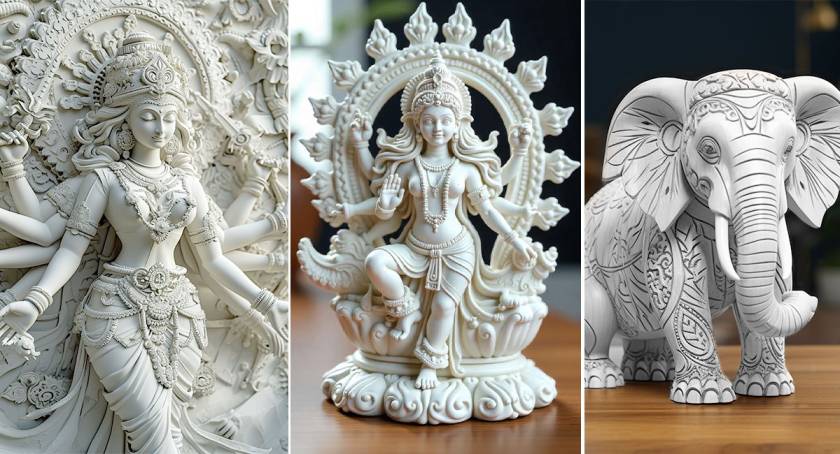Sholapith Craft
Odisha, a land of vibrant traditions and artistic excellence, is home to numerous handicrafts that embody the state’s cultural richness. Among these, artisans celebrate Sholapith craft for its intricate designs and delicate artistry. Made from the lightweight and spongy Sholapith, this craft is an age-old tradition passed down through generations. This blog showcases the fascinating world of Sholapith craft in Odisha, delving into its history, artistic significance, and sustainable artistry.
Origin and Cultural Significance of Sholapith Craft
Sholapith craft has deep historical and religious significance in Odisha. Traditionally, it has been an integral part of temple rituals and festivities. The lightweight and malleable nature of the material allows artisans to create stunning decorations, especially for deities during grand processions and festivals like Durga Puja, Rath Yatra, and Kali Puja.
One of the most revered shrines in India, the Jagannath Temple in Puri, prominently features Sholapith decorations. Intricate Sholapith embellishments also decorate the chariots of the annual Rath Yatra, highlighting the material’s association with spirituality and devotion.
The Artistic Process from Raw Material to Masterpiece
Creating a Sholapith masterpiece is a careful process that involves several steps. The process calls for accuracy, talent, and commitment from raw material to completed artwork. Let’s see the intricate process:
- Sourcing and Processing Sholapith
The journey of Sholapith craft begins with carefully selecting the plant, which thrives in Odisha’s wetlands. Artisans harvest the plant, strip its bark, and extract the inner pith, which is sun-dried and cut into sheets. The lightweight nature of the material allows for easy carving and manipulation.
- Carving and Molding
Talented artisans use traditional tools like knives, chisels, and delicate cutters to carve the Sholapith into complex designs. The soft material allows for detailed designs, making it ideal for creating delicate structures like floral motifs, idols, and decorative accessories. Molding and assembling these complex pieces is labor-intensive and requires immense precision.
- Coloring and Finishing
While many artisans retain the natural white of Sholapith for its elegance, others enhance their pieces with colors and embellishments. Gold foiling, silver dusting, and intricate painting are standard techniques used to elevate the aesthetic appeal of the craft. Some artisans incorporate additional decorative elements such as beads and sequins to make the artwork more visually striking.
Types of Sholapith Crafts in Odisha
Sholapith is a versatile material, lending itself to various artistic expressions. Some of the most popular forms of this craft in Odisha include:
- Temple Decorations
Sholapith is extensively used in temples, mainly to decorate deities and chariots during grand religious festivals such as the Rath Yatra in Puri. Its intricate floral and geometric patterns add a divine elegance to religious processions. Artisans often create elaborate canopies, backdrops, and embellishments for temple rituals.
- Wedding Ornaments
Traditionally, Odia weddings feature beautiful Sholapith ornaments, especially in bridal accessories. Crowns, tiaras, and garlands made from this material are considered auspicious and add a regal charm to the ceremonies. These delicate ornaments symbolize purity and elegance, making them a preferred choice for traditional weddings.
- Decorative Showpieces
Sholapith artisans craft stunning showpieces that adorn homes and offices, from miniature replicas of temples to elaborate wall hangings. These pieces often depict mythological tales, deities, and traditional motifs. The demand for such artifacts has increased among collectors and interior designers who appreciate handcrafted decor.
- Festival Decorations
Artisans use Sholapith decorations to create grand backdrops for idols during festivals like Durga Puja. The lightweight and easy-to-carve nature of the material make it perfect for complex designs in pandals and processions. The mesmerizing white structures add an ethereal beauty to the festival settings.
Sholapith Craft and Sustainable Artistry
Sholapith craft is an eco-friendly alternative to synthetic decorative items in an era of increasing environmental consciousness. Its natural plant source means it biodegrades rapidly and doesn’t add to pollution. This makes Sholapith craft an excellent choice for sustainable décor, aligning with modern efforts to promote environmentally responsible handicrafts.
Many artisans now incorporate eco-friendly practices in their production processes, ensuring minimal waste generation. Consumers becoming more aware of sustainable choices will likely demand more eco-conscious products like Sholapith craft.
A Craft Worth Preserving
Sholapith craft is a remarkable representation of Odisha’s artistic heritage, reflecting the delicate and divine essence of Indian artistry. Despite facing modern challenges, the craft holds immense potential for revival through awareness, innovation, and government and consumers’ support. By choosing Sholapith products, we embrace an exquisite art form and contribute to preserving a sustainable and culturally rich tradition.
Next time you encounter a beautiful piece of Sholapith art, remember the centuries of tradition and artistry that went into its creation. Let’s celebrate and support Odisha’s classic heritage!


